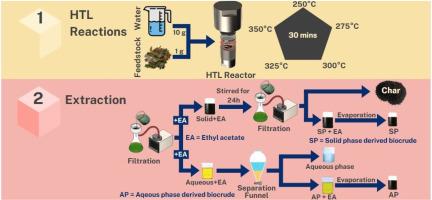固体废物液化生产强化生物原油的多级萃取工艺
IF 10
1区 环境科学与生态学
Q1 ENGINEERING, ENVIRONMENTAL
引用次数: 0
摘要
本研究以有机固体废弃物为原料,探讨水热液化温度和多级萃取方式对产品质量、产率的影响,以及潜在的反应机理。水热液化实验在250 - 350°C的5个温度范围内进行,产品成分使用热重分析、气相色谱-质谱分析和元素分析进行表征。结果表明,在300 ~ 350℃范围内,生物原油收率最高,为30 ~ 32%,多级萃取得到的生物原油热值较高,为40 ~ 43.7 MJ/kg。多级萃取法分离了大部分的氮氧杂环化合物,提高了生物原油的质量,得到的生物原油馏分轻67 ~ 70%。350°C的水热液化温度促进脱羧和脱氧反应,导致生物原油中羧酸含量较低,适用于燃料应用。以70.4%的高能量回收率和0.26的低能耗比评价了提取的能源可行性,证明了该工艺的净能源收益和可持续性。本文章由计算机程序翻译,如有差异,请以英文原文为准。


Multi-stage extraction process to produce enhanced biocrude from solid waste liquefaction
This study explores the effects of hydrothermal liquefaction temperature and multi-stage extraction method on product quality, yield, and underlying reaction mechanisms using organic solid waste feedstock. Hydrothermal liquefaction experiments are conducted at five temperatures ranging from 250 to 350 °C, and product compositions are characterised using thermogravimetric analysis, gas chromatography-mass spectrometry, and elemental analysis. The results demonstrate that the highest biocrude yield of 30–32 % is achieved within the 300–350 °C range, while multi-stage extraction produced biocrude with a higher heating value of 40–43.7 MJ/kg. The multi-stage extraction method enhances the quality of biocrude by separating most of the nitrogen and oxygen heterocyclic compounds and producing biocrude containing 67–70 % lighter fraction. The Hydrothermal liquefaction temperature of 350 °C promotes decarboxylation and deoxygenation reactions, resulting in lower amounts of carboxylic acids in biocrude, which are suitable for fuel applications. The energy feasibility of the extraction is evaluated by a high energy recovery of 70.4 % with a low energy consumption ratio of 0.26, demonstrating the process's net energy gain and sustainability.
求助全文
通过发布文献求助,成功后即可免费获取论文全文。
去求助
来源期刊

Journal of Cleaner Production
环境科学-工程:环境
CiteScore
20.40
自引率
9.00%
发文量
4720
审稿时长
111 days
期刊介绍:
The Journal of Cleaner Production is an international, transdisciplinary journal that addresses and discusses theoretical and practical Cleaner Production, Environmental, and Sustainability issues. It aims to help societies become more sustainable by focusing on the concept of 'Cleaner Production', which aims at preventing waste production and increasing efficiencies in energy, water, resources, and human capital use. The journal serves as a platform for corporations, governments, education institutions, regions, and societies to engage in discussions and research related to Cleaner Production, environmental, and sustainability practices.
 求助内容:
求助内容: 应助结果提醒方式:
应助结果提醒方式:


